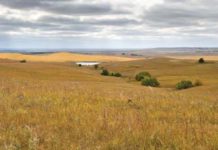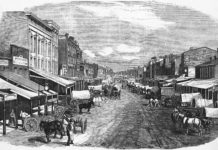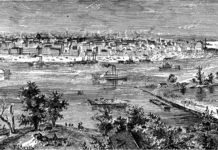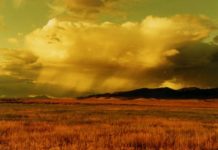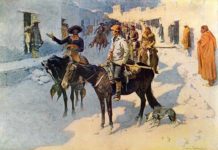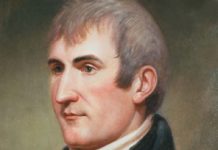Standing on the grounds of Fort Vancouver, Washington today I feel the spirits of the past beside me. I look around and envision what the fort used to be. It’s an easy task, as much of the fort has been reconstructed and stands just as it did when traders of the Hudson’s Bay Company in London established it in 1824. It was eventually moved closer to the Columbia River in 1829 to better accommodate the fur trade.
As the headquarters of the Pacific Northwest fur-trading empire it was touted as “the grand mart and rendezvous for the Company’s trade and servants on the Pacific.” Imagine the parade of furniture, men, supplies and furs that traveled to the fort when it was opened. They were shipped by ferry.
Fort Description and Christening
Trapezoidal-shaped, the original fort was 750 by 450 feet with a 20-foot high perimeter. There were twelve-pound cannons at the bastion at the northwest corner with the front door at the southeast gate providing a grand entrance to the Chief Factor’s house. That entire structure still stands today, parts of it restored the way it used to be.
Christened with a bottle of rum by Governor Simpson on March 19, 1825, it got a grand start under the helm of Chief Factor John McLoughlin who commanded the fort for 20 years. It wasn’t until 1846 the land became Oregon Territory and eventually, Vancouver, Washington.
Army Influence
In 1849 the US Army occupied the fort and lived alongside the Hudson’s Bay Company folks. This arrangement continued until 1860. The soldiers built barracks near the original fort and named it US Post Columbia Barracks. The name reverted to Fort Vancouver in 1853. A lot of the area still stands today, including Ulysses S. Grant’s house.
There’s an interesting story about Grant. He was a fort captain here in 1853 and was very into gardening. He couldn’t afford to bring his wife and young son to live with him, so he envisioned a garden whereby he could profit from the harvest to earn their fare.
He carefully sowed potatoes and oats with his pants tucked into his boots, a sheet tied to his neck and shoulders. Sad to say, the river overflowed and took out his crops. I’m not sure what happened after that.
Back in the fort’s heyday visiting Lieutenant Charles Wilkes portrayed a picture of the fort with his comments: It is a large manufacturing, agricultural and commercial depot [with] few, if any idlers, except the sick. Everybody seems to be in a hurry, whilst there appears to be no reason for it. It seems like he was describing today’s busy environment, doesn’t it?
Life at the Fort
The gates were opened daily between 9 a.m. and 6 p.m., though folks were let in between those hours if need be. Every half-hour you would hear the plaintive cry of the watchman, “…all’s well.” The fort and the surrounding community were home to lots of enterprise.
Children attended school, the first in the Pacific Northwest, at the Owyhee Church. There’s a Priest’s House, a jail, a carpenter’s shop (demonstrations are still given today) and a belfry whose bell timed the days activities and events. Nearby there was a counting house, the old office, a Catholic church, a wheat store, a beef store, the bastion, a sale shop where imported goods were sold and two identical buildings: the store and new store. The stone and brick powder magazine was designed to keep the powder fireproofed against harm.
The fur store stored all the furs that came through the fort. You could hear the songs of the trapper boats as far as two miles away as they transported their goods. The fort industriously shipped out $150,000 of furs annually.
Looking up, the flagpole was one of the first structures erected at the fort. Next to it was the trade shop, dispensary and Barclay Quarters (Dr. Forbes Barclay was the first doctor).
A newly married couple, James and Caroline Findley, came west in wagons for a new beginning. James caught “mountain fever” and didn’t make it, leaving Caroline to fend for herself; she joined her parent’s wagon. Three months later, in 1848, she gave birth at Fort Vancouver to a daughter.
Today you can still see blacksmiths providing demonstrations at the blacksmith shop. There was an iron store and the bachelor’s hall nearby. At night folks used chamber pots, but during the day the privies were their toilets, used also for fort garbage. The #2 well rose and fell with the level of the mighty Columbia.
Back then the bake house was a lively place where bakers cooked for up to 200-300 people at times. There was a washhouse and it’s not known today if it was used for washing clothes or for bathing. Every fort needs a harness shop and there was a kitchen full of fresh vegetables and fruit all year. Hunting parties provided meat. The Chief Factor’s house was the center of business and social activity. It was a nine-room white building surrounded by grapevine trellises. There were lots of dinners with diners seated around in their finest clothing, military folks in full dress with medals, sumptuous meals served with fine wines but no liquor. Pipes and snuff came out after dinner.
There was a great garden that is still maintained today with a semblance of how it looked back during the forts busy time. They grew wheat, oats, barley, corn, buckwheat and potatoes and planted orchards. Herds of cattle and horses also called the fort home.
The fort community included the company village, which housed company men and laborers, sometimes peaking to over 600 citizens. There was a cooper’s shop that manufactured barrels, a cemetery, shipping environment and lots of farming and industry activities.



